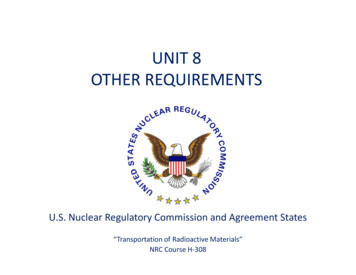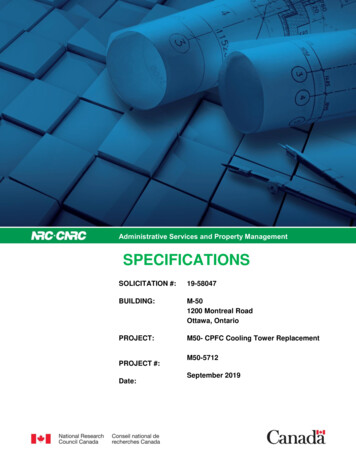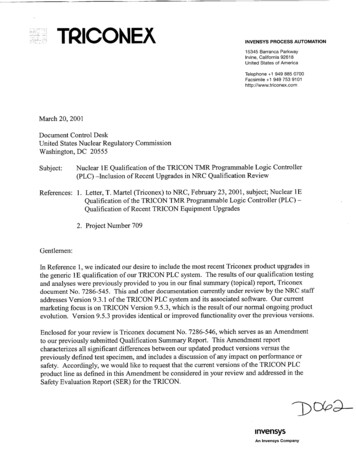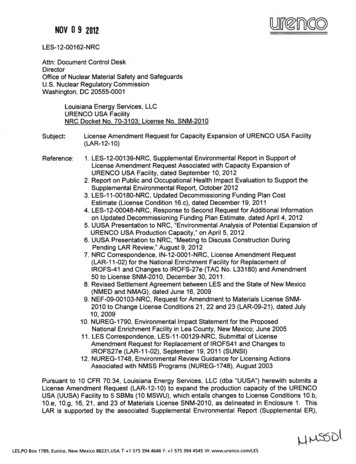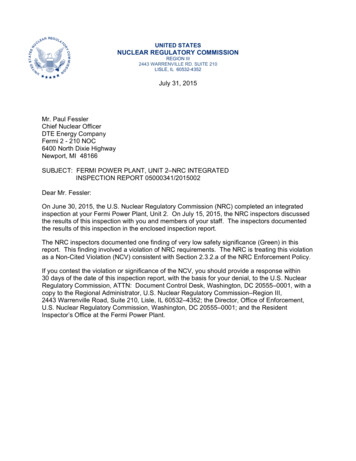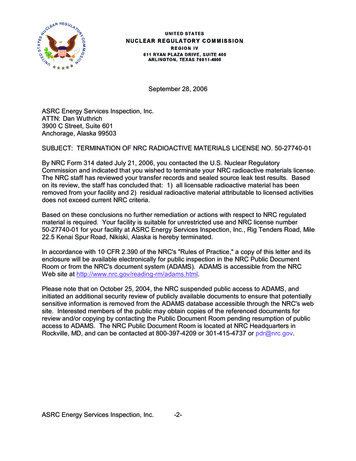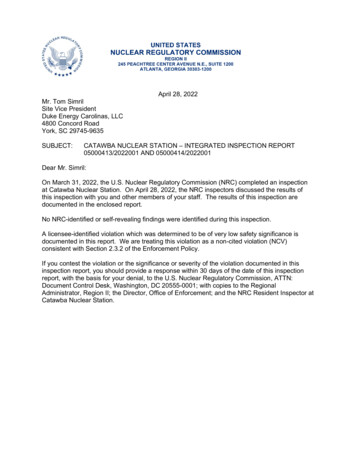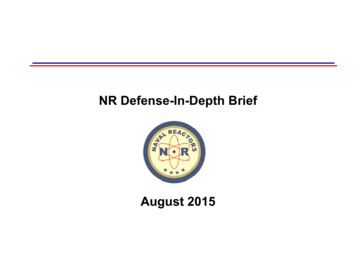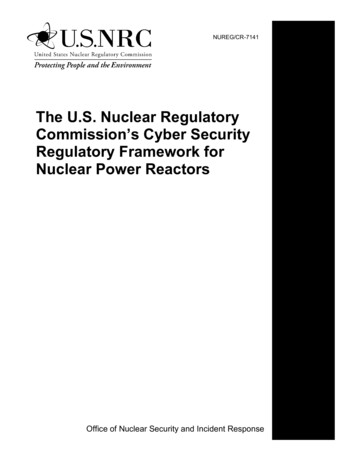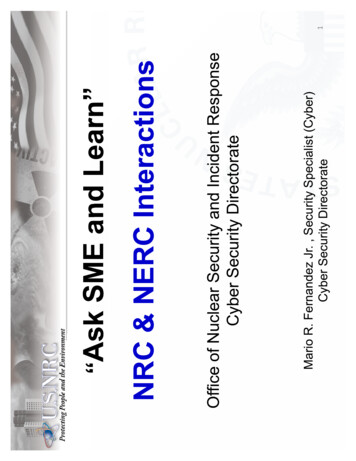
Transcription
What is Nuclear Energy?Electricity can be generated in different ways. For example, it can be madeusing solar panels, by burning coal, or by capturing the heat from atoms thatsplit apart. When the electricity is made from atoms splitting apart, it's callednuclear energy.“Thermal” power plants convert heat into electricity using steam. At nuclearpower plants, the heat to make the steam is created when atoms split apart— called fission. When atoms split apart, they release heat. When theprocess is repeated over and over, it is called a chain reaction. In a nuclearpower plant, uranium is the material used in the fission process.The heat from fission boils water and creates steamto turn a turbine. As the turbine spins, the generatorturns and its magnetic field produces electricity. Theelectricity can then be carried to your home, so youcan work on the computer, watch television or maketoast!About 20 percent of the electricity in the U.S. comesfrom nuclear energy. That means one out of everyfive homes in this country can turn on their lights dueto the atom!The U.S. Nuclear Regulatory Commission, alsocalled the NRC, regulates nuclear power plants. Wemake sure they are safe for people who work thereand live nearby, and for the environment.Nuclear ReactorsNuclear power plants are very complex. There are many different buildings at the site and many differentsystems. Some of the systems work directly to make electricity. Some of the systems work to keep theplant working correctly and safely. All nuclear power plants have a "containment structure" that holds thereactor. And all plants have deep pools where the nuclear fuel when it is no longer being used can becooled and stored.All nuclear power plants make electricity from the steam created by the heat of splitting atoms. But thereare two different ways that steam is used.Pressurized Water Reactors are known as "PWRs." They keep water under pressure so that it heats butdoes not boil. Water from the reactor and the water that is turned into steam are in separate pipes andnever mix.
Pressurized Water Reactors are known as "PWRs(Click for Larger Version) - View an Animated Image of a Pressurized ReactorBoiling Water Reactors are known as "BWRs." In BWRs, the water heated by fission actually boils andturns into steam to turn the generator. In both types of plants, the steam is turned back into water and canbe used again in the process.Boiling Water Reactor (BWR)(Click for Larger Version) - View an Animated Image of a Boiling Water Reactor
In all nuclear power plants, the process of making electricity causes radioactivity. The radioactivity comesfrom the splitting of the atoms. It must be carefully managed because it can be dangerous if not handledproperly. It can damage human cells or cause cancer over time. So all nuclear power plants have manysafety systems that protect workers, the public and the environment.For example, systems allow the fission process to be stopped and the reactor to be shut down quickly.Other systems cool the reactor and carry heat away from it. Barriers keep the radioactivity from escapinginto the environment.In reactors, radioactive material is contained inside small ceramic pellets about the size of the tip of anadult's finger. They are placed in long metal rods inside a reactor vessel, which is enclosed in a concreteand steel containment building. These buildings have walls three to five feet thick!
RadiationRadiation is naturally present in our environment. It can come from the sun and from certain rocks.Nuclear power plants also create radiation from the fuel they use and the process of creating electricity.Radiation must be managed carefully as too much can hurt people and the environment.Radiation is trapped and contained in several ways: Inside small ceramic pellets that are inside long metal rodsInside a "reactor vessel" where the fission takes placeInside the "containment building" that covers the reactor vessel and which is three to five feetthick!Small amounts of radioactivity can be released into the environment but only under controlled andmonitored conditions.There has only been one major accident at a nuclear power plant in this country. That accident happenedat Three Mile Island near Harrisburg, Pa., in March 1979. Some radioactivity was released into theatmosphere, but not enough to cause damage to the environment or people's health.A much more serious accident happened in 1986 at Chernobyl in the former Soviet Union. That accidentreleased a large amount of radioactivity into the environment. That reactor was very different fromreactors in the U.S. It was built without the containment that all U.S. plants have to keep radiation out ofthe environment during an accident.In Reactors, Radiation Is Trapped and Contained in Several Ways:EPA’s Radtown USA
Radioactive MaterialsRadiation is naturally present in our environment and is created by fission –splitting the atom to create electricity.Although too much radiation is harmful, there are many useful ways to useradiation to help people.Uses in IndustryA large piece of equipment called an irradiator can beused to sterilize medical equipment and even donatedblood. The exposure to radiation kills germs andprevents the spread of disease. Also, some things youeat may be sterilized by an irradiator to stay freshlonger or to be safer. How does it work? Radioactivematerial inside the irradiator sends a beam of radiationpowerful enough to kill germs. The beam does notmake the items radioactive, though, so they are safe touse afterward. And the radioactive material is shieldedso it doesn't hurt people.Some gauges use radioactive material. Gauges may use radioactive material to measure moisture in thesoil during road construction or to measure the thickness of products, like newspapers or plastics. Theradioactive material in gauges can measure theamount of air whipping into our ice cream!Special radiography cameras use radioactivematerials to take pictures inside walls or pipes. Theimage looks more like an x-ray than what you'd takewith your regular camera, though. The specialcamera can see if there are defects in an objectwithout damaging theobject.Some devices useradioactive materials tologging" devices are putSmokeTheif smokehelp find oil, natural gas and minerals. These "wellinto deep wells and help create a map of theunderground area.detectors use tiny amounts of radioactive material.material reacts with the air and can trigger an alarmis present.
Uses by Doctors and VeterinariansHospitals, doctors, dentists, and even veterinarians use radioactive materials. The materials helpdiagnose and treat illnesses, such as cancer. They are also used to study diseases. Thousands ofpatients are treated each year with radioactive materials in the United States.If you've ever had a CT scan or PET scan, you probably had todrink a liquid and sit or lie under — or inside — a big machine.That liquid had a small amount of radioactive material and,while it traveled through your body, the machine took picturesof your internal organs. Your doctor then looked at the picturesto see if anything wasn't working right.About 10 million "nuclear medicine" procedures happen everyyear in the United States so doctors can see inside theirpatients and figure out if something is wrong.Sometimes,radioactivematerial iseven used tofight diseases.It can killcancer cells orreduce pain.Tinyradioactiveseeds can beput inside apatient's bodyto kill acancerous tumor. Radioactive material can be swallowed,or powerful beams of radiation can be used to shrinktumors.And it's not just humans who can be helped.Veterinarians may use radioactive materials todiagnose, treat, and study illnesses in pets and otheranimals.Uses by Scientists or TeachersSome universities and colleges, high schools, andother academic and scientific institutions useradioactive materials in laboratory experiments andresearch. They can also be part of classroomdemonstrations. If you've ever done a gaschromatography experiment in a chemistry lab,you've used a device that contains radioactivematerial!
Archaeologists also use radioactive materials to determine the ages of fossils and other objects through aprocess called "carbon dating." Radioactive materials also play a role in space exploration. They supplyelectricity to satellites and to spacecraft that are sent on missions to the outermost regions of our solarsystem.Emergency PlanningThe NRC makes sure all nuclear powerplants in the U.S. have emergency plans –just in case. These plans are regularlytested with exercises and drills that simulatean emergency, just like fire drills at yourschool. Emergency planning includes theworkers at the plant. But it also includespeople who live near the plant, localofficials, and police and firefighters.If there is an emergency at a nuclear powerplant, the NRC is notified through a 24-houra-day Operations Center. The NRCinspectors who work at the plant and live inthe local community are also notified. If thesituation is serious enough, local officialsmay ask some people to evacuate. Other people in the community may be asked to "shelter in place."That means they need to stay indoors to be safe from radiation caused by the accident. During anaccident at a nuclear power plant, it's important that people who live near the plant listen to television orradio news, and follow the instructions of the people in charge.
SecurityNuclear power plants must be protected, since thematerial inside a nuclear power plant can be used byterrorists. Nuclear power plants have armed guards,many different kinds of fences and barriers, camerasand many controls on who can come into the plant.The security guards and the security plan for eachnuclear power plant are regularly tested by "mock"bad guys who try to invade the plant. These arecalled "force on force" inspections. They make surethe plant is fully protected.Security measures are very strict because protectingthe plant from sabotage or attack is important toprotect people and the environment. More detailsabout security plans are not available to the public.That's another way the plants are kept secure.
DecommissioningNuclear power plants are licensed by the NRC for 40years. After that, they can ask to renew their licenseto operate for more years, or they can shut down theplant. If a plant is going to be shut down, then it mustbe "decommissioned." Decommissioning meanstaking steps to reduce the level of radiation so thatthe land can be used for other things.This can be done in three ways. One way includessealing off the radioactive parts of the plant withconcrete and steel, which allows the radiation to "decay"until the land can be used for other purposes. The companymust tell the NRC which method they are going to use.The NRC has very strict rules for shutting down a plant. TheNRC requires plants to finish the process within 60 years ofclosing. It can be very expensive for power companies todecommission a plant. It may cost 300 million or more! Sothe NRC requires plant owners to set aside money when theplant is still operating to pay for the costs of shutting down inthe future.
Radioactive Waste/Spent FuelThe fuel inside a reactor doesn't work forever. As time goes on it works less and less effectively and mustbe replaced with new fuel. The old fuel is still very radioactive. After the fuel is removed from the reactorwith a large crane, it is put in a deep pool of water to cool. A typical nuclear power plant produces about30 tons of used fuel per year. We call it spent fuel.Spent fuel may stay in the pool or, after cooling it may betaken from the pool and put into large, heavy, concretecasks for storage. Eventually it needs to be placed deepunderground in a special disposal facility.Nuclear reactors also create another kind of radioactivewaste known as low-level waste. This waste is largelymade up of things used to keep the reactor clean andrunning that pick up radioactivity. Mops, rags, clothing,shoe covers, equipment, tools, filters and what is leftfrom treating radioactive water have enough radioactivitythat they need to be disposed in special facilities. Lowlevel waste disposal facilities also take radioactive wastefrom medical facilities and laboratories.
The fuel inside a reactor doesn't work forever. As time goes on it works less and less effectively and must be replaced with new fuel. The old fuel is still very radioactive. After the fuel is removed from the reactor with a large crane, it is put in a deep pool of water to cool. A typical nuclear power plant produces about

